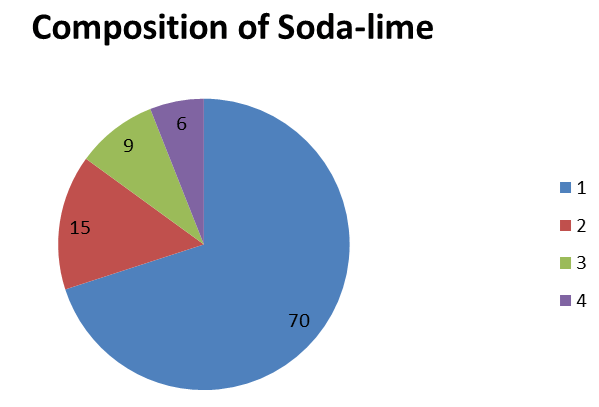This set of Ceramics Engineering Multiple Choice Questions & Answers (MCQs) focuses on “Classification of Ceramics”.
1. Given pie chart represents composition of soda-lime glass. What do the numbers 70, 15, 9 and 6 represent respectively?

a) Percentage of silica, sodium oxide, calcium oxide, other compounds respectively
b) Percentage of silica, sodium oxide, calcium oxide, alumina respectively
c) Percentage of silica, sodium oxide, alumina, boron trioxide respectively
d) Percentage of silica, alumina, magnesium oxide, other compounds respectively
View Answer
Explanation: The composition of a typical soda-lime glass consists of silica, sodium oxide and calcium oxide. It is made up of 70 wt% silica. Sodium oxide lowers the glass transition temperature. Calcium oxide provides chemical resistance to the glass. Other compounds may also be present.
2. What is the difference between glass and glass-ceramic?
a) Glass has lower glass transition temperature whereas glass-ceramic has higher glass transition temperature
b) Glass is noncrystalline whereas glass-ceramic is polycrystalline
c) Glass is pure whereas glass-ceramic is impure
d) Glass is crystalline whereas glass-ceramic is amorphous
View Answer
Explanation: Glass is usually noncrystalline. When glass is given proper heat treatment, it undergoes crystallization to form a fine-grained polycrystalline material called glass-ceramic. This is the major difference between glass and glass-ceramic.
3. Which of the following is used in devitrification process?
a) Silica
b) Alumina
c) Titanium dioxide
d) Lead oxide
View Answer
Explanation: Titanium dioxide is a nucleating agent. When it is added in glass during heat treatment, crystallization is induced. Good mechanical properties are achieved by this process. Silica, alumina and lead oxide are examples of some ceramics .
4. Bricks, tiles and sewer pipes fall under which category of ceramics?
a) Refactories
b) Clay products
c) Structural clay products
d) Whitewares
View Answer
Explanation: Structural clay products includes building bricks, tiles and sewer pipes. This category of ceramics involves applications where structural integrity is important. The whiteware ceramics become white after firing. Refactories are used in furnaces.
5. How does porosity affect strength of refractories?
a) Strength increases as porosity increases
b) Strength decreases as porosity decreases
c) Strength increases as porosity decreases
d) Does not have any effect
View Answer
Explanation: When porosity is present in refractories, air and other impurities are allowed to penetrate inside the material. This leads to oxidation of the materials which decreases the strength of the refractories. Therefore, lesser the porosity, stronger is the refractory material.
6. The surface structure of bonded abrasives should contain some __________
a) Impurity
b) Porosity
c) Slug
d) Metals
View Answer
Explanation: The surface structure of bonded abrasives should contain some porosity to allow some air currents and liquid coolant flow. This prevents excessive heating of refactory grains.
7. Coated abrasives are those in which an abrasive powder is coated on some type of paper or cloth material.
a) True
b) False
View Answer
Explanation: The abrasives class of ceramics is further divided into bonded abrasives, coated abrasives and loose grain abrasives. Coated abrasives are used for polishing purposes during metallography, that is why it is coated on a paper. For example, sandpaper.
8. Which of the following is used on a large scale in cement?
a) Portland cement
b) Rapid hardening cement
c) Quick setting cement
d) Low heat cement
View Answer
Explanation: Portland cement is produced by grinding and mixing clay and other lime-bearing minerals in proper proportion. It provides excellent load bearing properties and resistance to chemical atrack. It is used in construction of bridges, dams, etc.
9. What is the use of diamond films?
a) As an abrasive
b) Polishing
c) Substrate for semiconductor devices
d) Coating of grinding wheels
View Answer
Explanation: Diamond films have long range crystallinity therefore have high thermal conductivity. The mechanical and electrical properties of these films are similar to that of three-dimensional diamond. Because of their less thickness, they are preferred for semiconductor substrates.
10. Which type of bond is present between adjacent layers of carbon atoms in graphite?
a) Van der Waals
b) Hydrogen bonding
c) Covalent bonding
d) Ionic bonding
View Answer
Explanation: Each carbon atom is bonded to other three carbon atoms by covalent bond. These carbon atoms forms layers with hexagonal arrangement. The layers have weak Van der Waals forces that allow delocalization of electrons and conductivity.
Sanfoundry Global Education & Learning Series – Ceramics Engineering.
To practice all areas of Ceramics Engineering, here is complete set of Multiple Choice Questions and Answers.
If you find a mistake in question / option / answer, kindly take a screenshot and email to [email protected]
